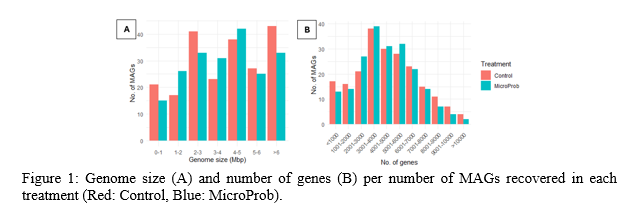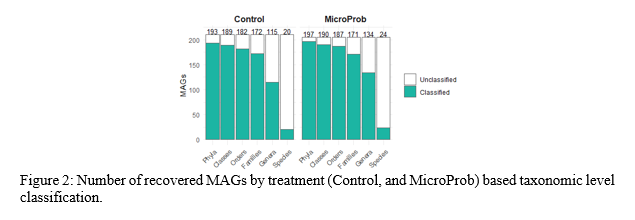DECODING THE BIOFLOC BLUEPRINT: METAGENOMIC INSIGHTS INTO THE RESHAPING OF AQUACULTURE MICROBIOMES
Introduction
The incorporation of microalgae and bacterial probiotics into Biofloc Technology (BFT) systems has received growing attention in recent studies focused on Penaeus vannamei culture. Supplementation with Chlorella vulgaris has been associated with improvements in water quality, growth performance, and overall shrimp health (Swapna et al. 2015). The present study aims to evaluate the potential benefits of such supplementation by characterizing the microbial community structure through metagenomic analysis. Special emphasis is placed on biofloc systems enriched with C. vulgaris and a commercial probiotic (Sanolife PRO-W, INVE).
Material and Methods
Two treatments were evaluated (MicroProb ) consisting of a biofloc system supplemented with C. vulgaris at a concentration of 7 × 10⁶ cells/mL and an initial dose of a commercial probiotic (Sanolife PRO-W , INVE) at 3 g/m³, followed by weekly maintenance doses of 1 g/m³, maintained under a 12:12h light:dark photoperiod; and (Control) a non-supplemented biofloc system maintained under continuous darkness (0:24h photoperiod). The microalgae culture was maintained at 28 °C and 21 PSU salinity, with continuous aeration and illumination ranging from 3,500 to 4,000 lux. The probiotic consisted mainly of Bacillus subtilis and Bacillus licheniformis spores at a concentration of 5 × 10¹⁰ CFU/g. P . vannamei (ρ= 205 animals/m2) were fed twice per day with a commercial feed (LeGoussant). Water quality parameters were maintained within optimal ranges for white shrimp (Van Wyk, 1999) and growth was assessed biweekly via random weight sampling (Kuhn et al., 2010). Biofloc samples were collected at the end of the experiment to ensure representative collection. Shotgun metagenomic sequencing using the Illumina NextSeq 2000 platform. Assembly and binning workflows (metaSPAdes and MaxBin2) enabled reconstruction of metagenome-assembled genomes (MAGs), which were taxonomically classified with GTDB-Tk and functionally annotated via Prokka and DRAM.
Results and discussion
Water quality parameters remained within optimal levels for white shrimp culture. Shrimp growth performance showed no significant differences between treatments . In the metagenomic analysis, bacteria, archaea, virus, and eukaryotic organisms were identified from the raw reads. However, the MAGs assembly was limited to bacteria and archaea, constraining subsequent analysis. A total of 205 and 210 non-redundant MAGs were recovered from the MicroProb and Control treatments, respectively, with similar proportions of bacterial and archaeal genomes (198 bacterial and 7 archaeal MAGs in MicroProb ; 204 bacterial and 6 archaeal in Control). Analysis revealed 26 MAGs exclusive to MicroProb , 28 exclusive to Control, and 19 shared across both treatments. MAG quality metrics, including completeness and contamination, were comparable between treatments. However, MicroProb showed a greater concentration of genomes with intermediate sizes (4–5 Mbp) (Figure 1A) and gene counts (3,000–6,000 genes) (Figure 1B), suggesting a more uniform and potentially functionally balanced microbial community. In contrast, the Control treatment showed a greater number of highly fragmented MAGs and genomes with extreme sizes.
Taxonomic classification was highly effective at higher taxonomic levels, successfully assigning approximately 89% of MAGs to the family level in both treatments. A total of 30 phyla, 56 classes, 91 orders, 118 families, and 24 species were identified. However, a substantial proportion of MAGs remained unclassified at the genus and species levels, indicating the presence of potentially novel or poorly characterized taxa (Figure 2). Dominant bacterial groups shared across both treatments included Pseudomonadota , Bacteroidota , and Planctomycetota (phylum level), Gammaproteobacteria (class), and Pseudomonadales (order), which are commonly reported in BFT systems (Baliga et al., 2021; Ghonomy et al., 2023). Notably, MicroProb displayed a higher abundance of families such as Halieaceae , Saprospiraceae , and Woeseiaceae (>5 MAGs), which were present only at low abundance in Control. These families have been linked to key ecosystem functions in BFT: Halieaceae and Saprospiraceae contribute to ammonium removal, while Woeseiaceae has been associated with anaerobic denitrification, enhancing nutrient recycling and system sustainability (Rajeev et al., 2024).
Overall, shotgun metagenomic profiling suggests that biofloc supplementation with microalgae and probiotics selectively enriched beneficial and functionally relevant microbial taxa. These changes support the hypothesis that targeted additives can restructure biofloc microbial communities, promoting ecological functions favorable for water quality and shrimp growth performance. A multikingdom analysis will be performed based on the metatranscriptomic assembly, enabling the identification and quantification of a wide range of eukaryotic organisms present in the biofloc.
Acknowledgments
This work was supported by European Union Next Generation -Plan de Recuperación-Ministerio de Ciencia e Innovación-Gobierno de España (TED2021-129272B-C21). T. Cascales contract was supported by European Union Next Generation-Plan of Conselleria d’innovació , Universitats , Ciència i Societat Digital of Generalitat Valenciana (INVEST/2022/434), and Research Personnel Training Grant (PRE2021-098367); supported by MCIN/ AEI/10.13039/501100011033/.
Bibliography
Baliga, P., Goolappa , P., Shekar, M., Girisha, S., Ramesh, K., Udyavara , V., & Venugopal, M. (2021). Bacterial communities associated with Penaeus vannamei Boone, 1931 surface and its rearing water in biofloc culture system. Asian Fish. Sci, 34, 34-46.
Ghonimy , A., Chen, Z., & Li, J. (2023). The effect of C/N ratio and its frequent addition on commensal and pathogenic bacterial abundances in shrimp Litopeaneus vannamei gut in a biofloc system: Ratio and frequent addition interaction matters. Plos one, 18(4), e0283841.

